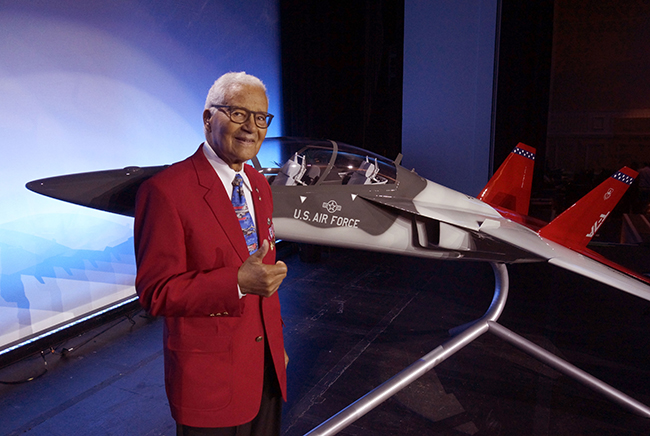
The new T-7A Redhawk USAF trainer was unveiled by a Tuskegee Airman. Staff photo by Mike Tsukamoto.
The Boeing T-X advanced trainer will bear the designation and name T-7A “Red Hawk,” Air Force Acting Secretary Matt Donovan announced Sept. 16 at AFA’s 2019 Air, Space & Cyber Conference, evoking and honoring the Tuskegee Airmen of World War II—who were known as the “Red Tails”—and the P-40 Warhawk fighter that the group flew when they began combat operations in Europe.
The new trainer also passed its Critical Design Review, just shy of one year from the contract award.
In making the announcement at AFA’s Air, Space & Cyber Conference in National Harbor, Md., Donovan was joined onstage by Tuskegee Airman Col. Charles McGee. Three more Tuskegee Airmen were also present in the audience for the naming. The T-7A, he said, will be the “new staple” of the Air Force pilot training experience, and its advanced technologies are symbolic of the service’s march toward a more sophisticated technological future. Donovan noted the T-7A’s “simulated radar, defensive management systems and other synthetic training capabilities” to prepare pilots for duty in a range of combat aircraft.
The first T-7A will arrive at Randolph AFB, Texas, in 2023, Donovan said.The naming comes a week after Boeing and the Air Force wrapped up a five-day Critical Design Review of the airframe portion of the project, Boeing program manager Steve Parker said in an interview at ASC19.
The CDR, conducted at Boeing’s facilities in St. Louis, Mo., was “very smooth” Parker reported.
“We did 12-13 pre-(preliminary design reviews)/CDRs over the past two months, to give the Air Force a super amount of detail,” and answered the service’s questions largely ahead of the formal review, he said. There were no issues coming out of the review, Parker said.
The review underscores the “very high degree of maturity” of the design, he said. “We are only 12 months out from the contract,” Parker said, yet the two initial aircraft that Boeing built for the competition have already racked up more than 100 flights.
“This is a different kind of CDR,” he said, “where you can go down and look at the actual aircraft and fly test points” to answer questions.
A systems requirements review is next. The training system element of the program recently passed a preliminary design review and Parker said it should get through its own CDR by the end of the calendar year.
The two initial aircraft resumed test flights in June, Parker said, and T-X No. 2 flew two flights on its first day flying after two years in storage, which is unusual, Parker said.
The two aircraft have flown 30 times since June, including a cross-country flight from St. Louis to Holloman AFB, N.M., with a stopover in Oklahoma City, Parker said.
Even though the Air Force has said it’s now eyeing other missions for the T-X—as a light attack airplane, a companion trainer, an Aggressor and as a potential export fighter—Parker said no changes or additions have been made to the project.
“We are laser focused” on fulfilling the engineering and manufacturing development contract, he insisted, saying that the EMD program won’t be affected by potential other applications of the jet. “We are on plan to the commitment we made” to produce at least 350 advanced trainer aircraft.
Boeing sees a market for 2,000 advanced trainers worldwide, but Parker declined to speculate on the market for a combat jet built around the T-X. He said “we designed it with a lot of capacity for growth,” meaning additional missions. “We think it will be very competitive, internationally.”
As for next steps, Parker said Boeing is already “machining metal” and will begin assembly next year of the first EMD aircraft. The test program will include five final-configuration aircraft in addition to the two competition aircraft, which parker called “production representative.” One change from the first two airplanes: The ejection seat will be an ACES 5 from Collins.
Two Air Force general officers—Air Combat Command chief Gen. James Holmes and 19th Air Force commander Maj. Gen. Patrick Doherty—have flown the T-7A, but no USAF test pilots have yet done so, Parker said.
He attributed the smooth progression of the T-7A to the Air Force’s early and regular communication with contractors as the program’s requirements took shape. He is “very pleased that we have had a year of no surprises.”